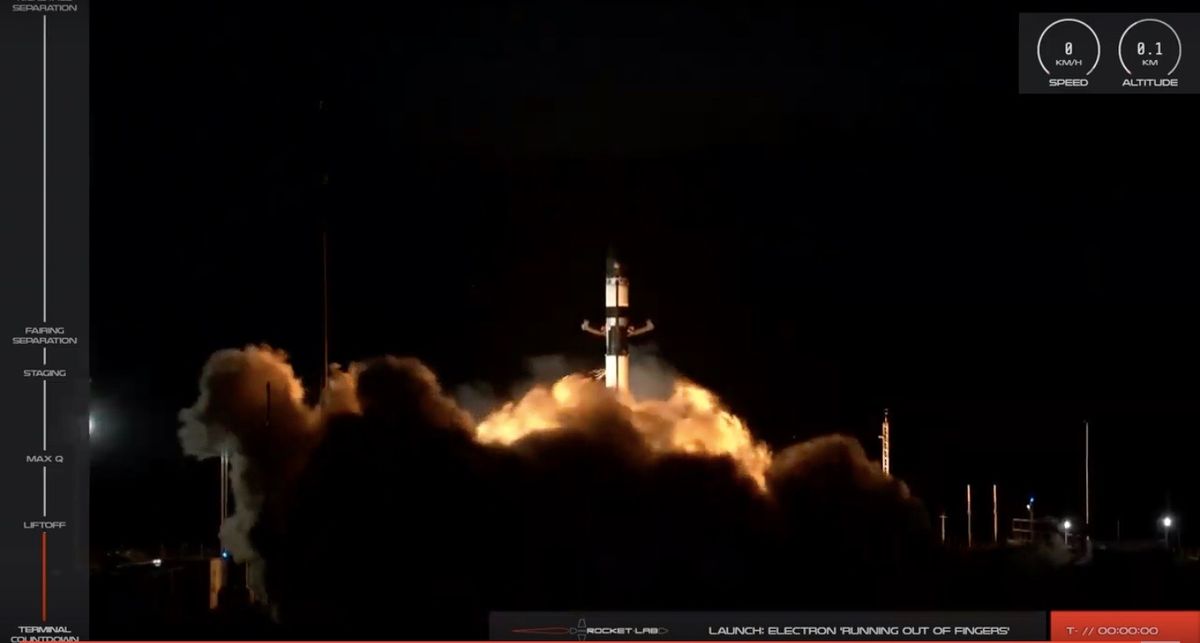
Rocket Lab just launched seven satellites to orbit, and learned a thing or two about bringing boosters back down to Earth for reuse.
A two-stage Electron rocket lifted off from the company's New Zealand launch site today (Dec. 6) at 3:18 a.m. EST (0818 GMT; 9:18 p.m. local New Zealand time), carrying an artificial-meteor spacecraft and six microsatellites high into the antipodean skies. If everything goes according to plan, all seven craft will be deployed about an hour after liftoff.
But there was action in the downward direction as well on this mission, which was the 10th-ever launch for California-based Rocket Lab. (The company, which has a history of giving its missions playful names, dubbed this one "Running Out of Fingers.")
Related: Rocket Lab and Its Electron Booster (Photos)
Path to rocket reuse
The first stage of this Electron was upgraded, "equipped with new guidance and navigation hardware (including S-band telemetry and onboard flight computer systems) and a reaction-control system to orient the booster during its atmospheric reentry," Rocket Lab representatives wrote in the mission press kit, which you can find here.
"This mission will play a key role in helping us gather data and iterate towards our first full recovery mission next year," they added.
That's right: Like SpaceX and Blue Origin, Rocket Lab plans to start reusing boosters. But the 57-foot-tall (17 meters) Electron is too small to feasibly make vertical, propulsive landings like SpaceX's Falcon 9 or Blue Origin's New Shepard, Rocket Lab CEO Peter Beck has said. So, the company intends to pluck falling Electron first stages out of the sky with a helicopter.
The main goal of recovery and reuse is to boost launch frequency, which is part of Rocket Lab's core mission of increasing access to space. The company eventually aims to launch at least once per week with Electron, which can loft about 500 lbs. (227 kilograms) of payload on each roughly $5 million mission.
"It's not about cutting costs at all, to be honest," Beck told Space.com in September, explaining that about 70% of the time and money spent on building each Electron goes into the first stage. "It's about increasing production. That's the sole reason we're doing it."
Seven satellites up
The artificial-meteor satellite that went up this morning on "Running Out of Fingers" is called ALE-2. The spacecraft was provided by the Tokyo-based company Astro Live Experiences, which envisions putting on sky shows to celebrate big events, such as Olympic Games opening ceremonies.
The 165-lb. (75 kilograms) ALE-2 is packed with 400 0.4-inch-wide (1 centimeter) balls that are designed to burn up high in Earth's atmosphere, generating "shooting stars" of various colors.
ALE-2 was preceded by ALE-1, which reached orbit aboard a Japanese Epsilon rocket in January. Neither satellite has deployed its colorful spheres yet, but that will likely happen next year, Astro Live Experiences representatives have said.
The other six craft that flew this morning are 2-inch (5 cm) "PocketQube" microsatellites from satellite manufacturer and mission management provider Alba Orbital.
"These six nanosatellites together represent five different countries and a range of technology demonstrations, including: LEO-to-LEO intersatellite link capabilities crucial to creating real-time global communications constellations; a payload built by university students in Hungary to measure human-made electromagnetic pollution; and a tester of new thermal isolation material for use in space," Rocket Lab representatives wrote in the mission press kit. ("LEO" is short for low-Earth orbit.)
Rocket Lab has some important milestones coming up in addition to next year's first planned rocket recovery. For example, the company aims to fly its Photon satellite platform for the first time in 2020 as well. And next month, Rocket Lab will officially open its second launch site, at the Mid-Atlantic Regional Spaceport on Virginia's Wallops Island.
This morning's launch was originally targeted for Nov. 29, but Rocket Lab stood down for about a week to conduct some tests with ground systems at the New Zealand launch site.
Mike Wall's book about the search for alien life, "Out There" (Grand Central Publishing, 2018; illustrated by Karl Tate), is out now. Follow him on Twitter @michaeldwall. Follow us on Twitter @Spacedotcom or Facebook.
https://news.google.com/__i/rss/rd/articles/CBMiS2h0dHBzOi8vd3d3LnNwYWNlLmNvbS9yb2NrZXQtbGFiLWxhdW5jaGVzLXNldmVuLXNhdGVsbGl0ZXMtcmV1c2FiaWxpdHkuaHRtbNIBT2h0dHBzOi8vd3d3LnNwYWNlLmNvbS9hbXAvcm9ja2V0LWxhYi1sYXVuY2hlcy1zZXZlbi1zYXRlbGxpdGVzLXJldXNhYmlsaXR5Lmh0bWw?oc=5
2019-12-06 08:35:00Z
52780466834718
Tidak ada komentar:
Posting Komentar